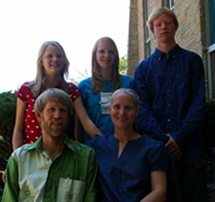After nearly ten years of living in Cameroon I finally got to go to the Far North Region. It was also a first time experience for Salome and Naomi, but Christi accompanies her partners here at least once a year. Twice before I had wanted to make this trip, but each time there were more travelers than seats available.
 |
Ready to embark on the journey with a small plane of the mission aviation service affiliated with Wycliffe Bible Translators.
|
|
Our visit coincided with the middle of the long dry season. Rain is not expected for at least another month. The wide rivers are dry and sandy, yet one finds people digging in the riverbed to reach the water hidden below. Many trees are dry and leafless and the dominant color is a sandy brown, except for the few villages where the roots of lush green mango trees tap into a higher water table.
 |
Salome and Naomi eating freshly toasted sesame seeds while taking refuge from the 100°F in the shade of a tree.
|
|
|
This was a work trip for Christi and me, but we took our daughters with the thought it could also give them rich, new experiences. Salome remembers: the wonderfully tasty meat and sauce we were served in a small hut at the first village we visited; the brief sight of a very quick yellow snake that zipped underneath Naomi as they sat outside; and the village where we had to go through two translators- one to go from a “very local” language to another more broadly used “local” language and then another to translate into French for our family.
 |
The community gathering place of Médjéréo, a large tree on a flat spot. A refreshing treat of hot, sweet homemade soy milk was served to us.
|
|
 |
Grain bank members of Gouzlom at their meeting place.
|
|
 |
Villagers of Mambaria share about the impact of the granary. Often men and women sit separately.
|
|
Naomi also recalls the wonderful meals we had in the villages, in contrast to the less appetizing eggs she had for breakfast at the hotel. She remembers the smell of dust filling the car as we drove down the road, the beauty of the seemingly dead trees in this dry season and the loud rumbling sound of the small plane.
I am left with many impressions from this trip: faces etched with character;
 |
Young mother listening to the discussions in Kelmey village
|
|
 |
Village elder with community worker Pierre Konaï to his left.
|
|
 |
Home on the side of a hill constructed with various materials (rocks and mud bricks) and styles (round and rectangular).
|
|
 |
Millet stalks remain on rocky mountain side after harvest. Farmers carefully sow grains in the few spots of dirt between rocks and boulders.
|
|
the diverse building styles of homes - rectangular or round, mud or cement blocks, or even well-fitted rock without mortar; and the severe living conditions in some the villages, where stalks of millet are planted between rocks and boulders on the sides of mountains.
I also am left with impressions of the pride, hope and determination evident in people we met.
There is pride in the way collaboration within their villages has produced successfully run community grain banks.
 |
Grain stocks in Gouzlom village. Bags are reused each year, save precious community funds.
|
|
 |
In addition to commonly held stocks of a union of 14 women groups, this well constructed granary in Kelmey is used to store personal supplies at a modest fee of about 50¢/bag/year.
|
|
Left: Records of stocks loaned and sold to the community members. A bag was sold at 15,000 F, while the market price at that moment (lean season) was 25000 F. New bags of grain were bought at harvest time for 10,000F. This has benefited the members, while allowing the community stocks to be replenished and enlarged.
|
|
|
|
There is hope that this common effort will continue to yield healthier and better fed families,
 |
A fun moment while cleaning millet grains.
|
|
 |
Four students from Gouzlom village who are now going to school, but could not do so prior to the creation of the community grain bank.
|
|
that it will help more children attend school, and enable fathers to stay in their village and work their own fields rather than to have to sell their labor cheaply in the fields of others far away.
I’ve seen the determination of parents who have taken a loan from RELUFA’s CAP Scholar program to send their daughters to school. Loans are taken at the beginning of the school year (September) and then repaid when their cash crop (cotton, peanuts or soybeans) are harvested and sold. That specific loan program is part way through the second cycle, but repayment at the end of the first year was 100%.
|

Christelle is able to attend high school because her parents have taken a short-term loan from RELUFA’s CAP for Scholars.
|
|
|
 |
Mazlaguidey women’s group gathered in front of their nearly finished restaurant. The women received for this project a CAP loan from RELUFA to serve meals to visitors of next door's Baptist hospital.
|
|
It is encouraging to see relatively small one-time investments by our church help communities start a community grain bank that year after year renders very tangible benefits. I am thankful for the dedicated Cameroonian community workers of RELUFA member organizations who through their regular visits do much to assure the success of granaries during their first few years.
